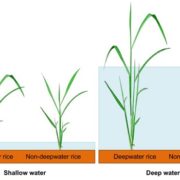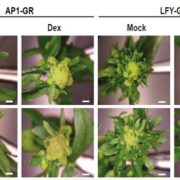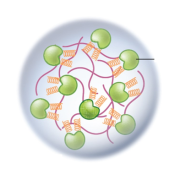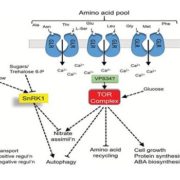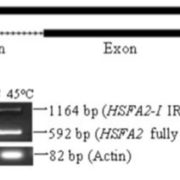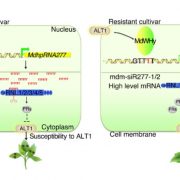Light Helps Plants Cope with Phosphate Starvation
Liu et al. focus on transcriptional regulation of PHR1 expression. The Plant Cell 2017. https://doi.org/10.1105/tpc.17.00268
Phosphorus (P) is an essential micronutrient for plant growth, development, and metabolism. Phosphate (Pi), the major form of P used by plants, is highly immobile in most soils, making it one of the most limiting nutrients for crop productivity. The overuse of P fertilizers has been rapidly depleting P resources and causing severe damage to the ecosystem. It is crucial to breed crops that can take up and use P more efficiently, but such efforts have so far met only limited success since we know little about the molecular mechanisms regulating Pi signaling and responses in plants.
To cope with Pi deficiency, plants have evolved many ways to remobilize and redistribute internal Pi and to better acquire Pi from the soil. Pi starvation responses include remodeling of 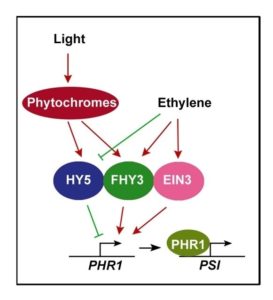 root system architecture (stopping primary root growth and increasing root hair and lateral root formation), reducing photosynthesis, enhancing Pi transporter activity, and accumulating starch and the pigment anthocyanin. How these activities are orchestrated is not yet well known. Arabidopsis PHOSPHATE STARVATION RESPONSE1 (PHR1) encodes a conserved transcription factor that helps program Pi starvation-induced gene expression and the resulting downstream Pi starvation responses. However, PHR1 expression is only weakly responsive to Pi deprivation stress. In this work, Liu et al. (2017) show that PHR1 expression is induced by light in a manner dependent on light receptors known as phytochromes.
root system architecture (stopping primary root growth and increasing root hair and lateral root formation), reducing photosynthesis, enhancing Pi transporter activity, and accumulating starch and the pigment anthocyanin. How these activities are orchestrated is not yet well known. Arabidopsis PHOSPHATE STARVATION RESPONSE1 (PHR1) encodes a conserved transcription factor that helps program Pi starvation-induced gene expression and the resulting downstream Pi starvation responses. However, PHR1 expression is only weakly responsive to Pi deprivation stress. In this work, Liu et al. (2017) show that PHR1 expression is induced by light in a manner dependent on light receptors known as phytochromes.
FHY3, FAR1, and HY5, three positive regulators of the phytochrome light-signaling pathway, directly bind to the PHR1 gene promoter. Strikingly, FHY3 and FAR1 activate, while HY5 represses, PHR1 expression. In addition, EIN3, a master regulator of the plant hormone ethylene, also directly binds to the PHR1 promoter and activates its expression. FHY3 directly interacts with EIN3, and HY5 can suppress the activation of PHR1 by FHY3 and EIN3. Finally, both light and ethylene promote FHY3 protein accumulation, and ethylene blocks the light-promoted stabilization of HY5. Therefore, it appears that light and ethylene coordinately regulate PHR1 expression and the phosphate starvation response through signaling convergence at the PHR1 promoter. These findings provide new insights into the molecular mechanism governing how light and ethylene together regulate Pi signaling and the phosphate starvation response. Such findings may ultimately help breeders design crop varieties with an improved ability to acquire and utilize Pi.
Liu, Y., Xie, Y.-R., Wang, H., Ma, X.-J., Yao, W.-J., Wang, H.-Y. (2017). Light and Ethylene Coordinately Regulate the Phosphate Starvation Response through Transcriptional Regulation of PHOSPHATE STARVATION RESPONSE1. Plant Cell DOI: https://doi.org/10.1105/tpc.17.00268.




